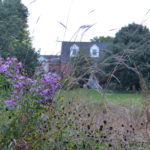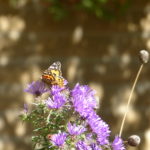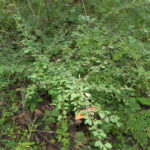by Marion Patterson | Apr 25, 2019 | (Sub)Urban Homesteading, Children/Play, Garden/Yard, Garden/Yard, Nature
-

-
Kids take to the woods.
-

-
Starting off carefully.
-

-
Walking confidently.
Kid Adventure
Nature reduces stress. We saw it in action at Winding Pathways on an early April Sunday morning.
About 15 kids from the Faith Formation Group of Peoples Church Unitarian Universalist visited. Most were five to ten years old. After collecting eggs and scattering treats for the hens, we took them to Faulke’s Heritage Woods. It’s a 110-acre woodland protected from development by a conservation easement held by the Iowa Natural Heritage Foundation.
It wasn’t a guided walk. It was a kid adventure. As we distantly watched, the kids scampered into the oaks where they discovered a huge fallen tree spanning a ravine. A natural bridge. They couldn’t resist making the crossing and then raced from fallen log to fallen log, traversing each. Laughter entertained the many standing trees as the kids were enveloped in nature, inventing games and having fun. No constructed playground in a city park or schoolyard matches the wonder and fun of ponds, prairies, and tiny streams.
-

-
Careful calculations
-

-
Learning to navigate a log.
-

-
Exploring the log
Lots of research has been conducted on nature’s ability to relieve stress in both adults and children. Experts call time spent in beautiful places the nature pill and even 20 minutes spent walking in the woods reduces stress.
Everyone Benefits
Mary Carol Hunter recently completed a nature pill study and said, “Our study shows that for the greatest payoff, in terms of efficiently lowering levels of the stress hormone cortisol, you should spend 20 to 30 minutes sitting or walking in a place that provides you with a sense of nature.”
We’re lucky to have Faulke’s Woods adjacent to Winding Pathways, but most of our time outdoors is spent close to our home on our own property. Often, it’s simply sitting in the yard enjoying a cup of coffee as we watch chickadees flit around.
Hunter’s words, “sense of nature” are powerful. Although visits to national and state parks, wildlife refuges, and nature preserves are wonderful stress relievers, anyone’s yard or balcony can do the same. We created Winding Pathways several years ago to encourage people to enjoy their yard, even if that’s a tiny apartment balcony in a big city. Structuring the yard or balcony to create natural beauty attracts interesting wildlife while giving people easy and free access to the “nature pill.”
Go outside and have fun, just like the kids did in Faulke’s Woods.
by Winding Pathways | Nov 29, 2018 | Garden/Yard, Mammals, Pests
After a balmy fall, the television weather report promised near record cold and snow in three or four days. Mice don’t have televisions but somehow, they knew this because several of the tiny mammals successfully entered our house just before cold arrived. One scurried across the floor as we were reading the morning newspaper.
Years ago we read our then young children a delightful book about a mouse in the house. The story goes: “There is a mouse in the house. It is a very nice mouse. It has a long, long tail and shiny eyes. My mother likes the mouse. But, she says, ‘A mouse does not belong in a house.’”
We agree and have developed a strategy to keep them out – at least most of them.
One tactic we do not do is poison. Karla Bloem of the International Owl Center in Houston, MN, reminds us that poison spreads. When a predator eats a poisoned mouse, it absorbs the poison. Over time, the poison builds up and kills the predator. People end up with more mice that can cause problems.
Here’s what we do at Winding Pathways:
- Encourage predators. We love to hear the barred owls call on dark evenings, and occasionally we spot a red-tailed hawk in a tree out the window. Both are outstanding mouse catchers. Owls work the night shift and hawks the day.
- Keep food secure. If mice smell dinner they’ll come right in uninvited and help themselves. It’s important to never leave food out unprotected. We store grain, flour, pasta, cookies and other foods in metal or stout plastic containers with tight-fitting lids. We don’t leave fruits and vegetables on countertops.
- Tighten up the house. Before it gets cold, we check our house over carefully. Any narrow cracks get filled with caulk. If we find a wider crack, we fill it with expanding foam. Often entry points for mice and insects are around pipes and wires leading into the home. Caulk and expanding foam help seal off the entry. Drain pipes sometimes are entry points. “Chore Girl” type metal cleaning pads work great for filling pipes where liquids or air needs to come and go. Wad up the metal pads and jam them into the pipe. Spaces in the cleaning pads let air and moisture enter or leave but keep mice out.
- Bring out the traps. Despite our best efforts, some mice make it into the house. Usually, we don’t see them but do see their calling cards – their tiny black droppings.
Effectively setting traps
Old fashioned mouse traps still catch mice efficiently, but a few tricks make success more likely. (With the exception of the poison information in this website, we have found this information to be appropriate.)
Bait. Probably the best bait is peanut butter. It just takes a tiny dab on the trigger to work.
Placement. Where you set traps is important. Mice naturally run along walls and dart under counters if they can. Traps set in the middle of a room are less likely to catch mice than those set along a wall with the trigger on the wall side.

Place several mouse traps where mice tend to enter.
Double up. It’s usually most effective to set several traps in the same spot. So, set two or three touching each other. The first trap or two might not catch the mouse. Usually one will
Keep setting the traps until you catch no more mice. Often people assume they have one mouse, but likely, there are more. Keep trapping until they’re all gone. We dispose of dead mice by simply tossing them outside for our local opossum to eat. They can be flushed down the toilet. Always be sure to wash your hands after handling mice or traps.
by Winding Pathways | Nov 15, 2018 | (Sub)Urban Homesteading, Bugs, Flowers/Grasses, Garden/Yard, Garden/Yard, Nature

Butterfly on plant
This past summer we enjoyed watching many monarch butterflies flutter over our prairie labyrinth. Numbers were way up from last year.
These intrepid insects are now en route to wintering grounds in Mexico. We look forward to their return next year.
Monarchs suffered huge population declines due to varied stresses on their lives. In farm country, most fencerows, waterways, and pastures that once harbored milkweed and wildflowers that provided both caterpillars and adults with food have disappeared. Today’s farmland is a pesticide-laced monoculture of just a few crops.
In town, manicured and sprayed lawns are as devoid of diversity as a cornfield and can’t sustain beautiful wildlife like butterflies.
The news would be more distressing had people not responded with enthusiasm to the monarchs’ decline. This summer we were delighted to see dozens of homeowners in Cedar Rapids and other towns let their lawns grow taller. Many planted pollinator patches in even tiny yards that include a diversity of native plants, including milkweeds. We took joy in seeing a small patch of milkweeds nurtured by the staff of a convenience store in a tiny patch of dirt near the gas pumps.

Grow a wild patch on your lawn to encourage butterflies.
Every pollinator patch, even if tiny, adds beauty and diversity to our world. We urge everyone to assist wildlife by creating natural plantings, even in urban areas.
Many Iowans have been inspired by the Monarch Zones Project. Founded by Clark McLeod, the Project provides workshops, encouragement, equipment, and seeds to help people assist this beautiful insect and hundreds of other beneficial species that add richness to our lives and health to the environment.
Next spring’s planting season isn’t far off. Now’s a fine time to plan to expand or create a pollinator patch in the yard. For help contact Monarch Research Project. Let’s continue to work together to create wondrous yards.
Bon voyage, Monarchs!
by Winding Pathways | Oct 25, 2018 | (Sub)Urban Homesteading, Flowers/Grasses, Garden/Yard, Garden/Yard, Nature, Reflections/Profiles
“It was amazing! Gorgeous! Fireflies danced over our prairie most of the summer, and they weren’t here when it was a mowed lawn,” said Katie Hill with much enthusiasm
She and her husband Tim are restoring an island of ecological health just three miles from downtown Cedar Rapids, Iowa. First Avenue is one of the busiest urban streets in Iowa, constantly filled with cars, motorcycles, and trucks. A bald eagle flying over the road would look down at an urbanized landscape – except for five acres of verdant beauty just a few feet east of the Avenue. The oasis is nestled between suburban developments, a high-rise condominium, and a senior residence complex.
Katie and Tim bought three and a half acres and a home about 15 years ago. It was convenient to his work at a law office a stone’s throw from their land. “We did the standard expected landscaping of mowing and spraying for about a decade,” she said.
Creating Habitat
Although the yard was large it lacked plant diversity and wildlife. Then came the change.
“We stopped spraying and I took delight when creeping Charlie and dandelions took hold. Many people don’t like them, but creeping Charlie has a gorgeous flower that bumblebees love, and it smells nice. Dandelions are beautiful, and bees love them,” she said. Then she broadcast prairie seed on a low area that had been lawn. After a couple of years big bluestem, Indian grass, and many native flowers appeared. Encouraged by their first prairie the Hill’s planted new ones in formerly mowed and sprayed lawns. They’ve been helped by David Novak, owner of a small company that helps people restore natural areas.
“We were delighted when lightning bugs appeared over the prairie. They don’t like mowed lawn but love taller plants. We watch them dance on summer evenings. These beautiful insects completely avoid the mowed lawns of our neighbors,” Tim and Katie remarked.
Early in 2018, the Hills bought about an acre and a half of land adjoining their property Years before several houses stood on the property but it had been purchased by a developer who planned to build two condominium towers. He razed the houses and built one condo tower but abandoned plans to build the second.
Restoring the Land
As we walked through the area Katie showed us her new prairie plantings in what had once been a lawn while Tim pointed out where the houses had stood. As the years go by the residents of the existing condominium tower will gaze downward during the day on wildflowers dancing in the breeze and butterflies sipping nectar from prairie blooms. As twilight approaches, they’ll enjoy fireflies blinking their tiny lights.
In addition to creating beauty and feeling the joy of making the earth healthier, the Hills are benefiting the community beyond their property. Prairie grasses absorb stormwater that once sheeted off their land and into storm sewers and eventually Cedar Lake. Their land nurtures wildlife as its beauty increases and diversifies.
“We feel good about what we are doing. We are helping nature restore itself in the heart of the city, but it also does one other thing. When we were mowing and spraying it was costing us about $600 a month to maintain the property. Now that’s dropped to about 90 bucks, so we’re saving money,” the Hills explained.
In the process of restoring their land, Tim and Katie Hill are also getting a fulfilling ecological education.
Win! Win! Win!
“It’s a win, win, win,” smiled Katie. “It’s a win for us saving money. It’s a win for us to have the time to be entertained by the wildlife diversity. And, most importantly, it’s a win for Mother Nature.”
-

-
New England Asters grace the prairie.
-

-
Butterflies have flocked to the Hill’s property.
-

-
One of their many cats relaxes on the patio.
-

-
A Monarch perches in the lee of a tree resting before leaving for the south.
-

-
Owners of an urban oasis.
-

-
Beautiful sunset.
by Winding Pathways | Sep 20, 2018 | Chickens, Energy Efficiency, Flowers/Grasses, Garden/Yard, Garden/Yard, Nature
It’s turning time for wildlife, chickens, and people
As the Northern Hemisphere of the earth continues its ageless slow wobble away from the sun, days gradually shorten until a wondrous event happens.
The Autumnal Equinox happens around September 21st each year. It’s when daily hours of sunlight equal those of darkness. On only two days each year does every place on earth enjoy roughly 12 hours of sunshine. These are the fall and spring equinoxes. So, whether someone lives near the tropics or poles they will experience the same amount of light on only those two days.
Light changes quickly around equinox time. Up here in the Northern Hemisphere days shorten quickly and darkness advances until the December 21st Winter Solstice, the year’s darkest day. The Southern Hemisphere begins to enjoy its longest days through December.
Preparing
At Winding Pathways around the Equinox, we do these things:
- Stimulate our chickens. We plug in the timer and light bulb in the coop. Chickens lay the most eggs when there are about 15 hours of daylight. So, the coop light is set up to come on about 4:30 a.m. and turn off about three hours later when the sun pokes over the horizon.
- Drain, clean, and invert our rain barrels. We won’t need extra water until next spring, so we turn the barrels upside down, so they don’t collect winter water that freezes and can split the barrels. We weight them with stones to keep Arctic winds from blowing them away.
- Watch this short video on how to Prepare Rain Barrels
- Bring in pumpkins and winter squash. A frost is soon to come, and we don’t want it to bite our squash. We store

Winter Squash vary in color, texture, shape and size.
pumpkins and squash in a room we rarely use. It stays cool but above freezing. Butternut, Acorn, Hubbard, and most other winter squashes and pumpkins, which actually are a squash, keep for months and give us delicious and vitamin stoked food on cold days.
- Exclude, or try to, insects and mice. Somehow mice, box elder bugs and Asian beetles sense coming cold and find tiny cracks to enter the house and enjoy winter warmed by our furnace and wood stove. Each fall we caulk up cracks and weather strip doors to encourage them to stay outside where we prefer to see them. It’s never perfect. Some always find their way inside.
- Enjoy leaves. Each’s fall’s spectacular leaf color peaks in October but some leaves start turning sooner. Our backyard black walnut starts coloring up in early September. The real show is the deep orange, red, and yellows of our sugar maples. They peak in early to mid-October followed by russet oak leaves.
-

Fall wildflowers are an important food source for insects and birds.
Enjoy wildflowers. Asters, Goldenrods, and Maximilian Sunflowers are the very last blooms of the season. Their colors brighten the yard and provide nectar for insects and then seeds for migrating and overwintering birds. But all this comes with sadness as we know we’ll not see wildflowers again until next spring.
- Watch wildlife. It’s migration time and one of the best seasons for seeing unusual birds. We often look upward and sometimes spot pelicans and waterfowl winging high overhead. By now deer in their subdued winter coats are sleek and well fed on a diet of acorns. Bucks have polished their antlers. Chipmunks and squirrels scurry about caching winter food.
We’d like to hear what you enjoy about the Equinox time. Please email us your joys and projects in this wondrous season.
by Winding Pathways | Aug 2, 2018 | Garden/Yard, Nature, Pests
Mugging Barberry

It’s a tough task eradicating Barberry.
One pleasant Saturday morning a couple dozen heavily armed people walked to the interior of Faulkes Heritage Woods. Their weapons were those used to help heal the forest and included thick leather gloves, lopping shears, hand saws, and clippers. They were out to defeat Japanese Barberry.
For two hours they attacked a huge patch of Japanese Barberry that had infiltrated the Woods. Grasping small ones with both hands people yanked them from the soil, shook them off and placed them so the roots would dry out and not re-root. In winter, when the Barberry has berries, the plants are placed on tarps and hauled off so the berries do not drop and root. Ones too big to pull were cut off at ground level.
Volunteers were organized by the Iowa Natural Heritage Foundation. It holds a conservation easement on the property that’s owned by the Marion City Parks Department. Park staff helped, and so did a crew of young people enrolled in AmeriCorps. Various local volunteers pulled and cut.
In Its Native Habitat, It is OK.
Just why is Japanese Barberry such an onerous plant? Actually, it’s a fine shrub in Japan and other parts of Asia where it’s native. There it has natural forces that keep its density in check. It was brought to North America as a landscaping plant because barberry is easy to propagate and transplant. It thrives in many locations, including compacted soil of building sites. It is an ideal landscape plant with one terrible trait.

Barberry creates impenetrable tangles and changes the soil chemistry.
The plant produces red fruits in late summer that birds find delicious. They gobble them up, fly away, and poop the seeds out. So, birds snacked on barberries planted in yards and delivered the seeds into Faulkes Woods, where the seeds grow with gusto into impenetrable “pukka brush”.
Barberries crowd out native wildflowers and do much more damage. They actually change the soil chemistry to their advantage while making it less suitable for native plants. And, the dense shrubs create pockets of humidity. Each becomes an oasis of comfort for ticks.
Preserving and Exploring Faulkes Heritage Woods

Many hollows and ravines characterize Faulkes Heritage Woods.
Faulkes Heritage Woods is a gorgeous 110-acre steep forest adjoining Winding Pathways. We walk there often. Huge oaks and other native trees fill its wondrous spaces. Wildflowers abound, especially in the spring, and birding is excellent for woodland species. Pileated woodpeckers are common.
A looping footpath starts and ends at a trailhead off Tama Street Southeast. Visitors can park along the street and enjoy the woods. But, they don’t have to stick to the trail that only covers a small area. Walkers are welcome to go off trail and scramble through the woods to enjoy its beauty and solitude.
For information:
Marion Parks and Recreation: (319)447-3580
Iowa Natural Heritage Foundation: (515)288-1846
Winding Pathways LLC.




















